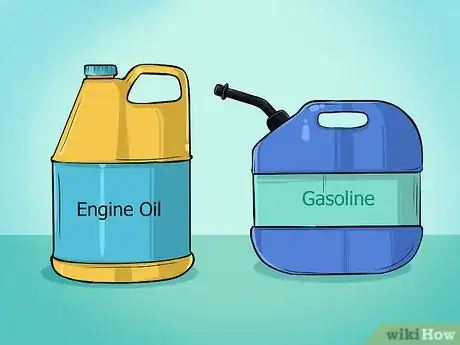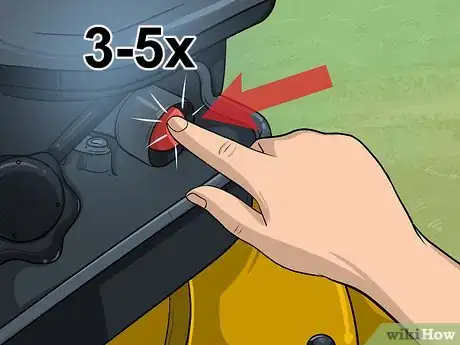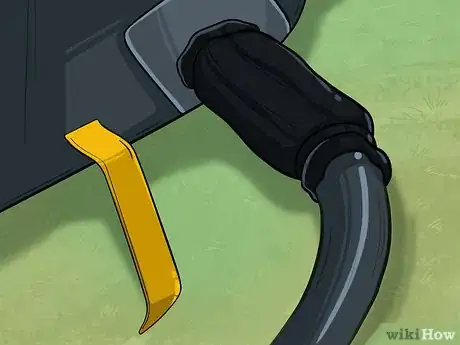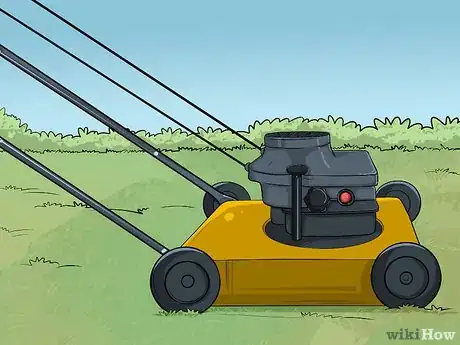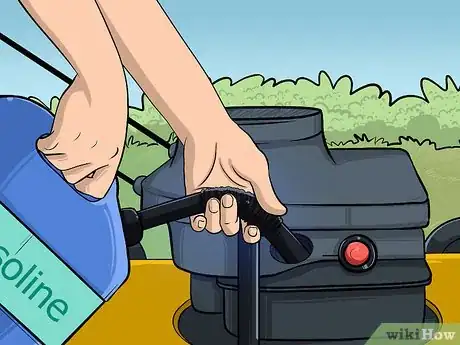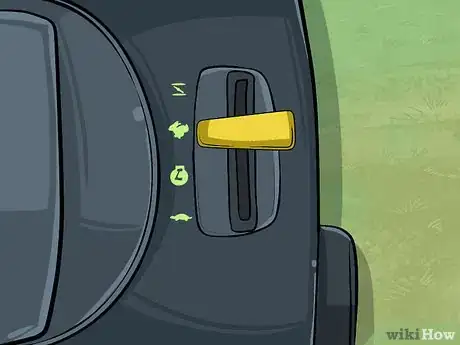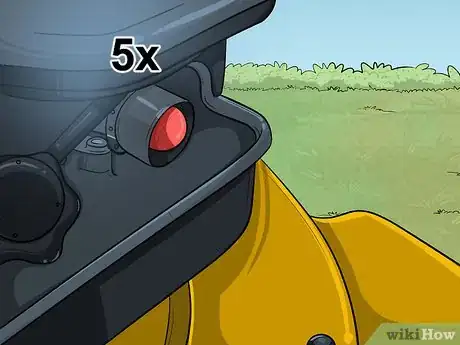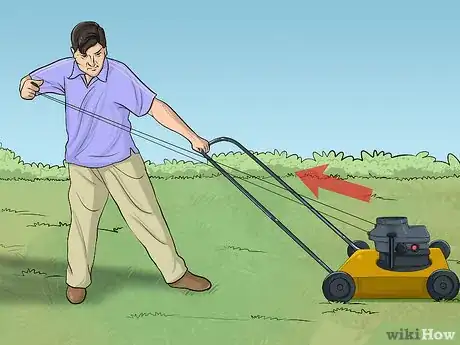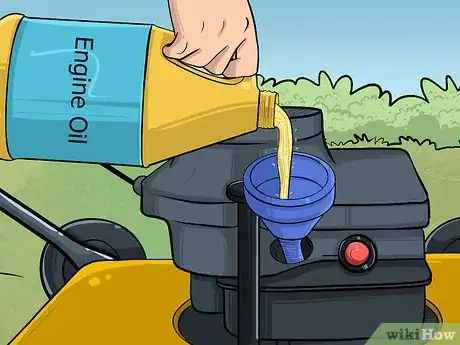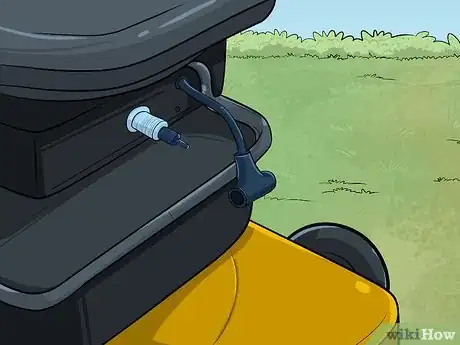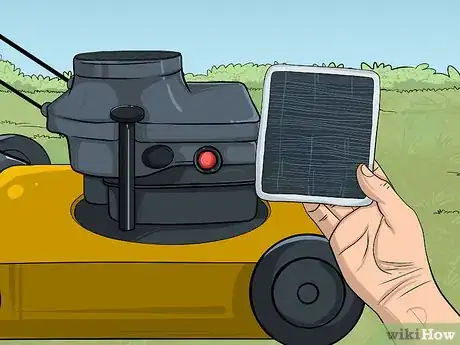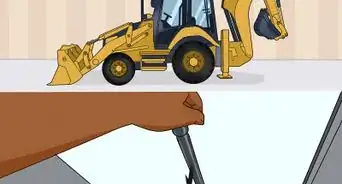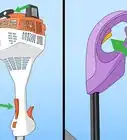This article was co-authored by Grant Wallace. Grant Wallace is a Landscaper and Owner of Grantlanta Lawn in Atlanta, Georgia. With over seven years of experience, he specializes in lawn maintenance and landscape installation. In 2012, he earned his BA from the University of West Georgia. Grant has been profiled in Shoutout Atlanta, Canvas Rebel, and Voyage ATL.
This article has been viewed 44,767 times.
If you’re planning to do substantial yard work or cut grass, you’ll need to be able to start and use a lawn mower. Lawn mowers typically come in two varieties: the common pushing variety, and the riding lawn mower. The mechanics of starting each is similar: make sure that the mower has plenty of new gasoline, and pull the starting cord firmly. If either style of mower isn’t starting correctly, you’ll need to troubleshoot the engine, spark plug, and air filter.
Steps
Starting a Traditional Lawn Mower
-
1Make sure that the lawn mower has both oil and gas. This step is especially important if this is your first time using a new lawn mower: check the oil and gas tanks and make sure that both have been filled properly, in accordance with the guidelines set out in the owner’s manual.[1]
- Lawn mowers run best off of fresh, clean unleaded gasoline. This can be the same as the type that you put in your vehicle. The gas should be at least 87 octane, and should not contain higher than 10% ethanol.[2]
- Gasoline with higher ethanol levels is corrosive, attracts water, and can damage the interior of the lawn mower’s gas tank.
-
2Press the primer button 3–5 times if the mower has been inactive. If you have never used this particular lawn mower before, or if the mower has been active for an extended period of time (for example, over the winter), you’ll need to press the primer button a few times. This will channel gasoline into the mower’s engine.[3]
- If you’re not sure which is the primer button, check for a diagram or schematic in the owner’s manual. This will show the layout of the lawn mower, including the primer button.
Advertisement -
3Pull the lever near the top of the handle toward you. If you stand behind the mower (in the position from which you’ll push it to mow your lawn), you should see a bar or lever by the top of the handle. Grasp this lever and pull it towards you, holding it against the top bar of the mower. You should be able to hold the lever and bar together in one hand.
- This lever needs to be in “starting” position before you pull the starting cord. Also, in order for the lawn mower’s motor to keep running, you’ll need to keep holding this lever while you use the mower.
-
4Pull the starting cord several times. The starting cord should be on the base of the lawn mower, and will have a plastic cord to grasp. Hold onto this firmly, and give the starting cord a single smooth, long pull upward. Do not jerk or yank on the cord. Pull quickly until the cord has fully extended. If the mower has not started, repeat the process several times.[4]
- Some models of lawn mower will have more than one handle attached to the starting cord. If this is the case with your model, hold both handles in one hand and use them both to pull forcefully on the starting cord.
Starting a Riding Lawn Mower
-
1Add new gasoline. Riding mower engines can be temperamental when filled with old gasoline. Refill the gas tank with new gasoline each time you start to lawn mower to make sure that old gas has not deposited gel, gum, or varnish inside of the gas tank. Newer gas will help the mower start more reliably and quickly.[5]
- Old gas which has been sitting in the gas tank for more than a couple of months can attract moisture and potentially corrode the gas tank. To avoid this, try to use up nearly all of the gas each time you use the mower, and don’t let old gas remain in the tank for months.
-
2Adjust the throttle control. The throttle control—commonly called a “choke”—is a device on engines which adjusts the amount of air which can be pulled into the engine when starting. Blocking more air will result in a richer fuel blend being pulled into the engine and will help it start more readily. When starting the engine, adjust the choke to restrict air from entering the engine. If the choke is manual, this setting should be clearly marked. Refer to the mower manual if you need help locating or using the throttle control.[6]
- After the lawn mower engine has started and is running, you can open the choke so that more air can enter the engine. This will keep the mower from dying while you’re using it.
- On some riding lawn mower models, the throttle control is entirely automatic and inside the mower.
-
3Push the primer button 5 times. For the comparatively large engine of a riding mower, you’ll need to use the primer button to direct gasoline into the engine. The primer button will pull gasoline into the carburetor, making it easier for the engine to start. This will also reduce the number of times you’ll have to pull the starting cord.[7]
- If you’re unsure of the location of the primer button, check the riding lawn mower manual for a diagram showing the location of the lawn mower’s parts and buttons.
-
4Pull firmly on the starting rope. Grasp the handle firmly and pull the cord rapidly outward until you feel resistance. It may take 4 or 5 pulls on the starting rope for the engine to catch and start running. While you’ll need to pull quickly and firmly on the starting rope, don’t jerk or yank it. Repeated yanking motions will break the cord or the plastic handle.[8]
- If this doesn’t start the engine, press on the primer button another 3 or 4 times, and then begin pulling the starting rope again.
Troubleshooting a Lawn Mower That Won’t Start
-
1Replace the fuel. If your lawn mower has sat unused for more than a couple of months (and especially if it’s sat for an entire winter), the gasoline in the tank may have gone bad. Drain this gasoline and dispose of it safely. Then fill the lawn mower tank with fresh gasoline.[9]
- If the mower’s gas tank doesn’t have a drain plug, you may need to use a length of hose and siphon the gas from the tank.
-
2Check the spark plug. If the spark plug in the lawn mower engine is wet with liquid or gasoline, the mower will not successfully start. Remove the spark plug, and clean it using carburetor cleaner and a damp rag. The solvent in the carburetor cleaner will cut through and remove any oil residue that may be stuck on the spark plug. Then let the spark plug dry before reinserting it into the lawn mower engine.[10]
- If you need assistance opening the engine or finding the spark plug, you can refer to the lawn mower manual, which should contain a diagram of the engine.
- You can purchase carburetor cleaner at a local auto supply store.
-
3Check the air filter. The air filter keeps dust and grass bits from entering your mower’s engine. If the lawn mower’s air filter has become excessively dirty or flooded with gasoline, the machine won’t start properly. The air filter will either be a paper filter (housed in a small cylinder) or a foam-type filter (housed in a sardine-can sized metal rectangle). Remove their air filter and inspect it: if the filter is clogged or dirty, you may need to replace it. This will allow the engine to get enough air and start properly.[11]
- If you’re unsure of the air filter’s location, refer to the lawn mower manual. This should provide a diagram with the location of the air filter and other engine components.
- You can purchase a new lawn mower air filter at your local hardware store. Air filters may also be sold at an auto parts store, or at a large retailer like WalMart.
Warnings
- Never operate a lawn mower while intoxicated or under the influence of any substances.⧼thumbs_response⧽
- Use caution when operating lawn mowers. Do not allow children or pets to be near a running lawn mower. Watch that your hands and feet do not come into contact with the blades.⧼thumbs_response⧽
- Clear foreign objects off the lawn before you start, and be careful to not run over any hoses or sprinkler heads while mowing your lawn. Also be on the lookout for children’s toys or dog toys.[12]⧼thumbs_response⧽
Expert Interview
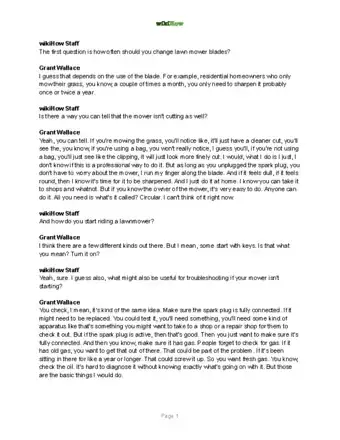
Thanks for reading our article! If you'd like to learn more about starting a lawn mower, check out our in-depth interview with Grant Wallace.
References
- ↑ https://www.bobvila.com/articles/how-to-start-a-lawn-mower/#.WM1kKfnyvIU
- ↑ https://www.briggsandstratton.com/na/en_us/support/faqs/browse/fuel-recommendations.html
- ↑ https://www.bobvila.com/articles/how-to-start-a-lawn-mower/#.WM1kKfnyvIU
- ↑ https://www.bobvila.com/articles/how-to-start-a-lawn-mower/#.WM1kKfnyvIU
- ↑ https://dengarden.com/landscaping/Why-Wont-That-Lawnmower-Start
- ↑ https://dengarden.com/landscaping/Why-Wont-That-Lawnmower-Start
- ↑ https://dengarden.com/landscaping/Why-Wont-That-Lawnmower-Start
- ↑ https://dengarden.com/landscaping/Why-Wont-That-Lawnmower-Start
- ↑ https://www.bobvila.com/articles/how-to-start-a-lawn-mower/#.WM12HvkrLIW
About This Article
Before starting a traditional lawn mower, check the oil and gas tanks and make sure that they’re full. If the mower has been inactive for an extended period of time, press the primer button 3 to 5 times to channel the gasoline into the engine. Next, pull the bar or lever by the top of the handle towards you, and hold it against the top bar. With your other hand, pull the starting cord several times to start the mower. For more advice from our Horticulturist reviewer, including how to troubleshoot a mower that won’t start, keep reading!
